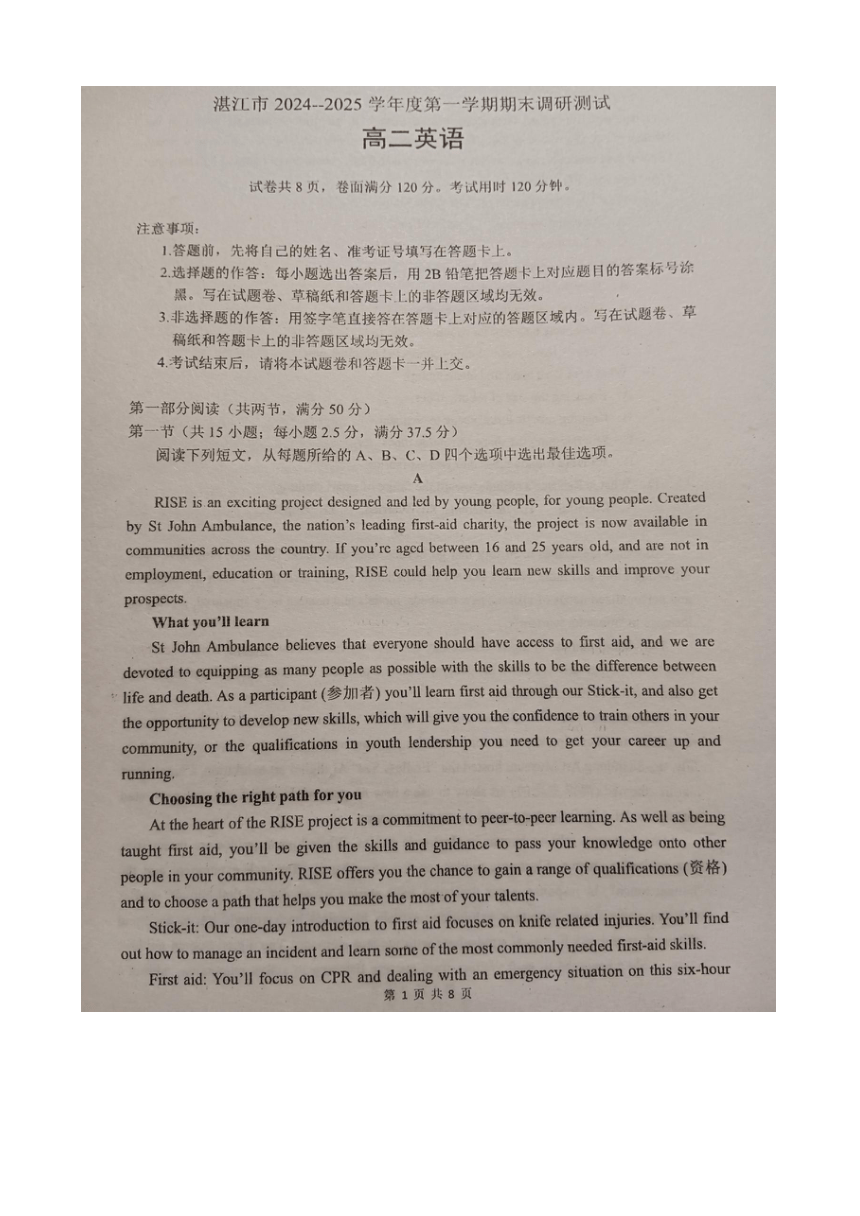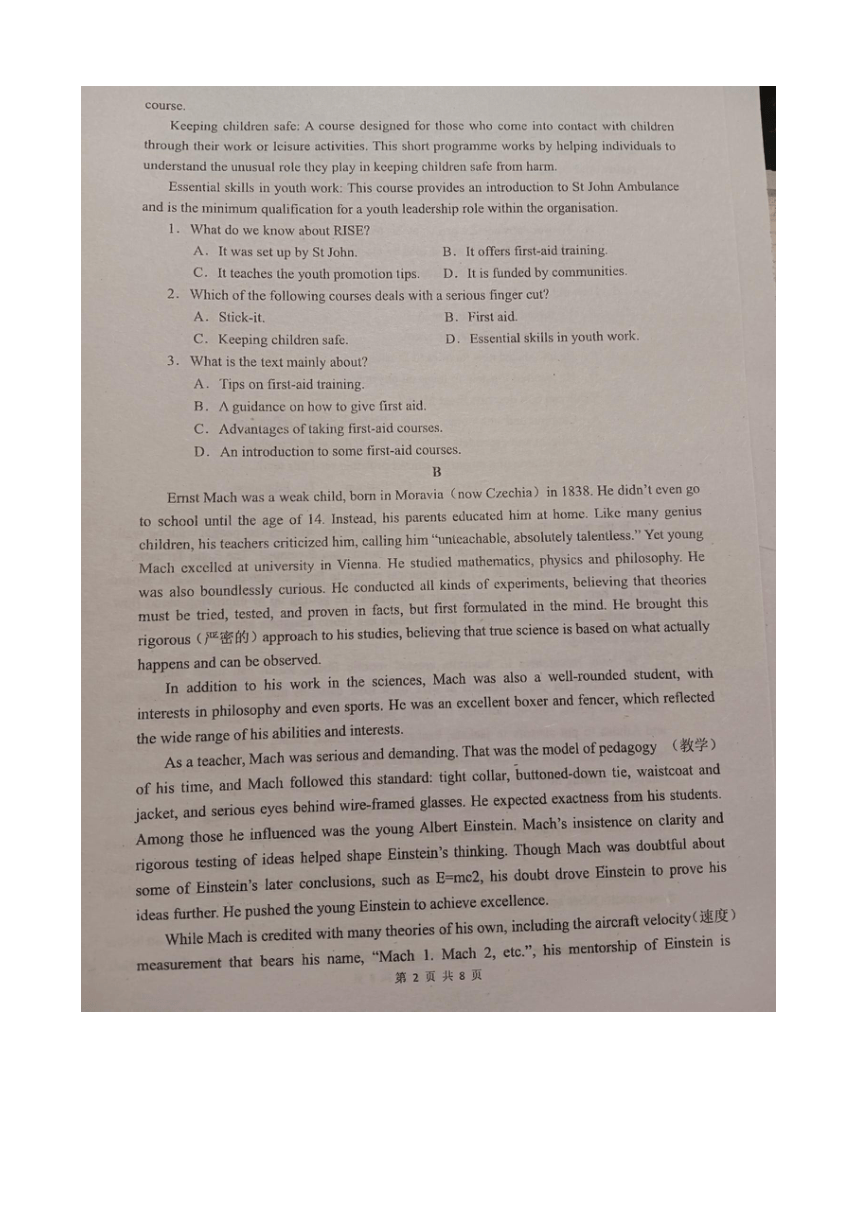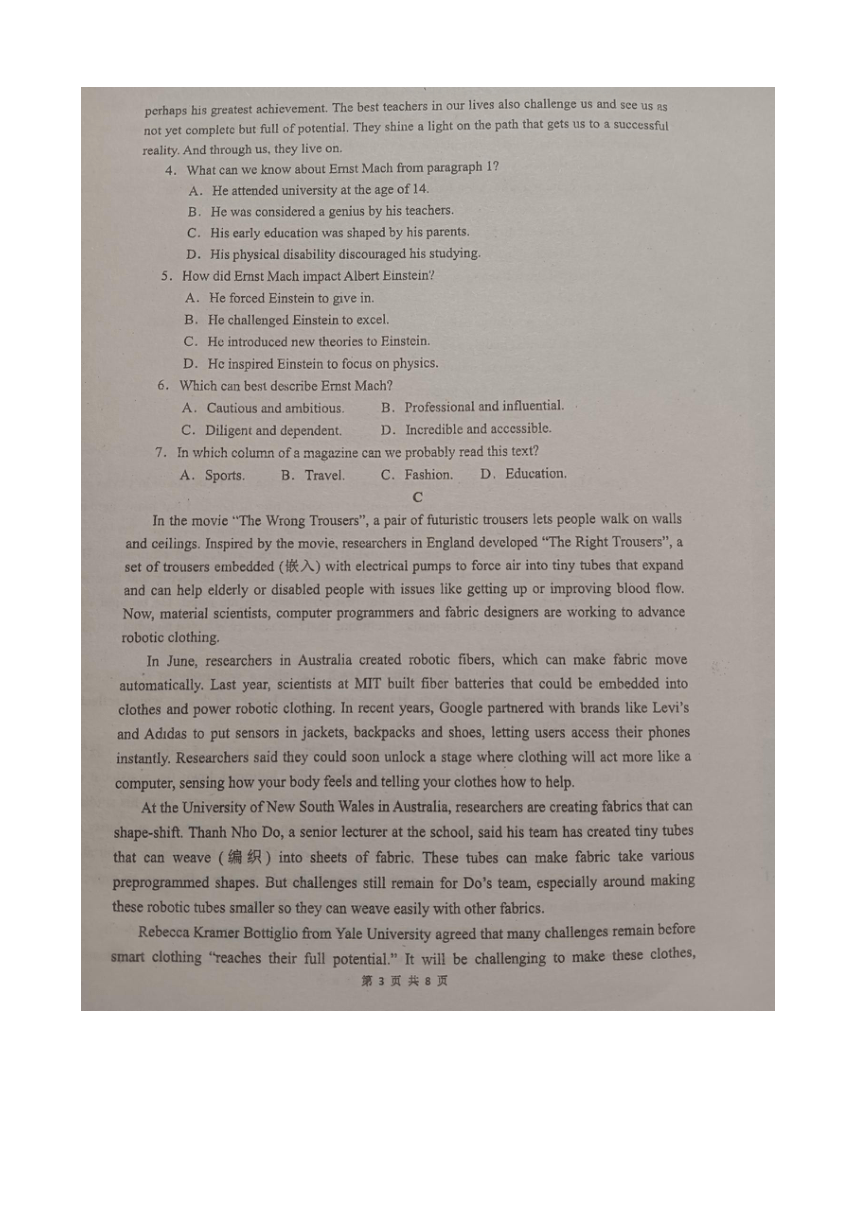广东省湛江市2024-2025学年高二上学期期末调研考试英语试卷(图片版无答案)
文档属性
| 名称 | 广东省湛江市2024-2025学年高二上学期期末调研考试英语试卷(图片版无答案) |  | |
| 格式 | docx | ||
| 文件大小 | 2.6MB | ||
| 资源类型 | 教案 | ||
| 版本资源 | 人教版(2019) | ||
| 科目 | 英语 | ||
| 更新时间 | 2025-01-22 13:53:18 | ||
图片预览




文档简介
equipped with fibers and technology,strong enough to go through multiple yles in the
laundry(洗衣房),she said.Despite that,she says reerhers will figureouaway forward..
"Recent breakthroughs point toward a not-so-distant future where smart clothing will be a part
of our everyday life."she said.
8.What led to the creation of"The Right Trousers"
A.An electrical pump.
B.A health issue.
C.A tiny tube.
D.A creative film.
9.What did scientists at MIT do last year
A.They put sensors in clothes.
B.They created movable robotic fibers.
C.They made batteries for robotic clothing.
D.They released smart clothing connected to cellphones.
10.What does Do's team find challenging
A.Reducing the size of robotic tubes.
B.Keeping robotic tubes'shape unchanged
C.Programming the shape of robotic tubes.
D.Weaving robotic tubes into various fabrics.
11.What is Rebecca's attitude toward the future of smart clothing
A.Doubtful.B.Indiffcrent.C.Worried.D.Hopeful.
D
Museums are echoes of history that go beyond time and space.Recently,they have been
attracting more and more visitors excited to experience culture directly.To meet the different
and personalized needs of visitors,new methods,models and content have appeared,driving an
increase in“museum tourism”.
The widespread use of digital technology has not only reduced the upkeep costs of cultural
objects but also greatly cut down the geographical and physical boundaries of cultural resources,
improving the visitor experience.
Technologies like XR glasses and 3D displays able to be enjoyed without special
equipment are becoming key tools for interaction,enhancing the museum visitor experience.In
July,the Shandong Art Museum hosted the"Endless Sea"AI digital art exhibition,China's first
marine-themed(海洋主题的)art show to use a new Al--generated content and user-.generated
content model,offering a deep,multi-layered experience.
Most museums rely on human or electronic guides.While human guides are interactive,
they can be expensive.Electronic guides,on the other hand,often lack excitement and the
"human touch".In response,some museums have started trying out"digital-human"guides
who can show maps,introduce exhibition,explain historical backgrounds,serve as brand
ambassadors and mix historical atmosphere with modern elements.The digital-human guide is
a new method designed to shift visitors from passive listening to active interaction,adding a
第4页共8页
laundry(洗衣房),she said.Despite that,she says reerhers will figureouaway forward..
"Recent breakthroughs point toward a not-so-distant future where smart clothing will be a part
of our everyday life."she said.
8.What led to the creation of"The Right Trousers"
A.An electrical pump.
B.A health issue.
C.A tiny tube.
D.A creative film.
9.What did scientists at MIT do last year
A.They put sensors in clothes.
B.They created movable robotic fibers.
C.They made batteries for robotic clothing.
D.They released smart clothing connected to cellphones.
10.What does Do's team find challenging
A.Reducing the size of robotic tubes.
B.Keeping robotic tubes'shape unchanged
C.Programming the shape of robotic tubes.
D.Weaving robotic tubes into various fabrics.
11.What is Rebecca's attitude toward the future of smart clothing
A.Doubtful.B.Indiffcrent.C.Worried.D.Hopeful.
D
Museums are echoes of history that go beyond time and space.Recently,they have been
attracting more and more visitors excited to experience culture directly.To meet the different
and personalized needs of visitors,new methods,models and content have appeared,driving an
increase in“museum tourism”.
The widespread use of digital technology has not only reduced the upkeep costs of cultural
objects but also greatly cut down the geographical and physical boundaries of cultural resources,
improving the visitor experience.
Technologies like XR glasses and 3D displays able to be enjoyed without special
equipment are becoming key tools for interaction,enhancing the museum visitor experience.In
July,the Shandong Art Museum hosted the"Endless Sea"AI digital art exhibition,China's first
marine-themed(海洋主题的)art show to use a new Al--generated content and user-.generated
content model,offering a deep,multi-layered experience.
Most museums rely on human or electronic guides.While human guides are interactive,
they can be expensive.Electronic guides,on the other hand,often lack excitement and the
"human touch".In response,some museums have started trying out"digital-human"guides
who can show maps,introduce exhibition,explain historical backgrounds,serve as brand
ambassadors and mix historical atmosphere with modern elements.The digital-human guide is
a new method designed to shift visitors from passive listening to active interaction,adding a
第4页共8页
同课章节目录
